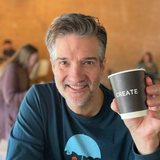№ 84 | The StoryTelling Leader, Content Patterns, Defining Transdisciplinary Research, the Serious Games Idea Deck, the Map of Board Games, and Andrew Garfield and Elmo on Grief

The StoryTelling Leader
I recently started following David Hutchens on LinkedIn. As it turns out… I already I own two of his books (Circle of the 9 Muses and Outlearning the Wolves) and his card deck (below) 🤪. Anyway, when it comes to narratives—specifically leadership stories—he knows his stuff!
1/ Over the past several weeks (in a series of LinkedIn posts) he’s been sharing how his own thinking on story taxonomies has grown and changed over time—always a strong mark in my book!
2/ Then, there was this podcast where David explores How to Tell a Story About Yourself. The podcast is less of an interview, and more like eavesdropping on a coaching session, as David critiques two stories created by the host of the Coaching for Leaders podcast; since listening to this, I’ve been thinking a lot about (a) ‘what my stories might be’, and (b) how David looks for “a challenge and a choice” in every leadership story, regardless of pattern.
3/ Finally, his Leadership Story Deck (described in the podcast ^^^) is filled with great content. Each of the 27 story cards offers the expected description content, but also a 5-movement skeleton structure to get you started with each type of story. Then, on the back side, an example for each kind of story. Moreover, and especially important to a card nerd like myself, the deck also includes several “recipe” cards for when you need to string together a series of the story patterns.

Speaking of story patterns, here’s a completely different take on the topic…
Content patterns
Here’s an excellent post from Lauren Pope on “Information patterns and narrative structures in content.” Unlike the story patterns identified by David Hutchens, this is a broad survey of 10 different ways to structure content (think 5 paragraph essays or the inverted pyramid from journalism). Upon seeing this, I wondered why we haven’t seen something like this sooner! Bonus points for the simple visual summaries…

…and the handy ‘which narrative should I use? matrix:

The former English teacher in me couldn’t help but see how this could be useful to grade school students, to support intentional thinking about different ‘go to’ writing structures. Oh, and it’s easy to imagine these patterns being transformed into a card deck, right?! 😉
Speaking of visual summaries…
Defining Transdisciplinary Research
Confession: I don’t know that I’ve paused to consider the differences between multidisciplinary, interdisciplinary, and transdisciplinary. Fortunately, this “schematic representation” (adapted from this paper?) [LinkedIn] makes clear the nuanced differences between these different terms!

Serious Games Idea Deck
Instructional design professor Karl Kapp just released this Serious Games Idea Deck. It’s pitched as “a collaborative game designed to help players explore and discuss aspects of game design,” with (given Karl’s expertise), a special focus on designing learning games. I haven’t yet got my hands on a copy, so no comments on the content, but… I’m a bit smitten by this simple layout pattern: A single, central, hexagon card off of which you play cards from each of the six suits. This isn’t the first game to do something like this (see Turing Machine or a classic domino game like Chickenfoot ), but… something about the specific application of this pattern has my mind spinning with other creative possibilities, and constraints (e.g. certain suits can only have one cards, while others may have many).

Here’s an unboxing video from Dr. Kevin Thorn, CNH [LinkedIn] that offers more detailed information about this deck.
Speaking of tabletop games…
The Map of Board Games
I’m sharing this Map of Board Games as a playful thing to think with, as it’s a fantastic overview of the landscape of modern board games (and what isn’t a game), for gamers and non-gamers alike. As a self-confessed board game geek, I enjoy the organization of game types and concepts. But, as with Domain of Science’s other maps (check out this fabulous map of mathematics!), this is a great orientation for everyone to the broad and rich space of board games:
Andrew Garfield and Elmo on Grief
Let's wrap up this edition of the newsletter with something more immediately human-centered and positive: Check out this moving chat between Andrew Garfield and Elmo, which is itself a model for good asking and listening skills. Something for all of us, not just the kiddos!






